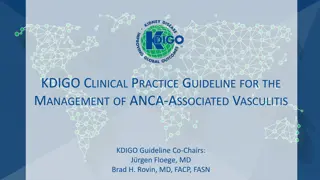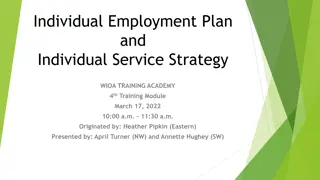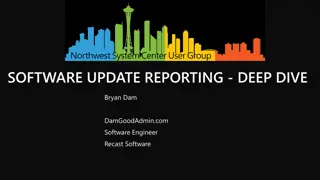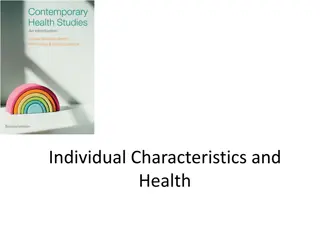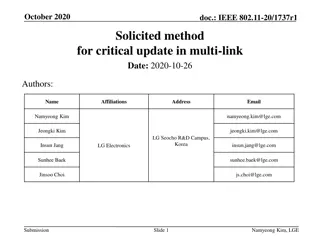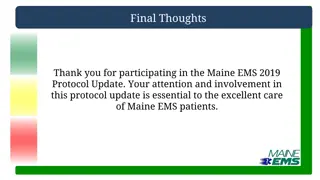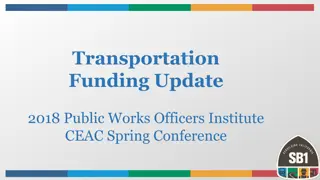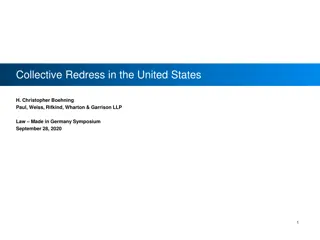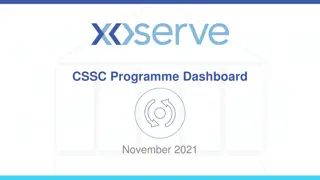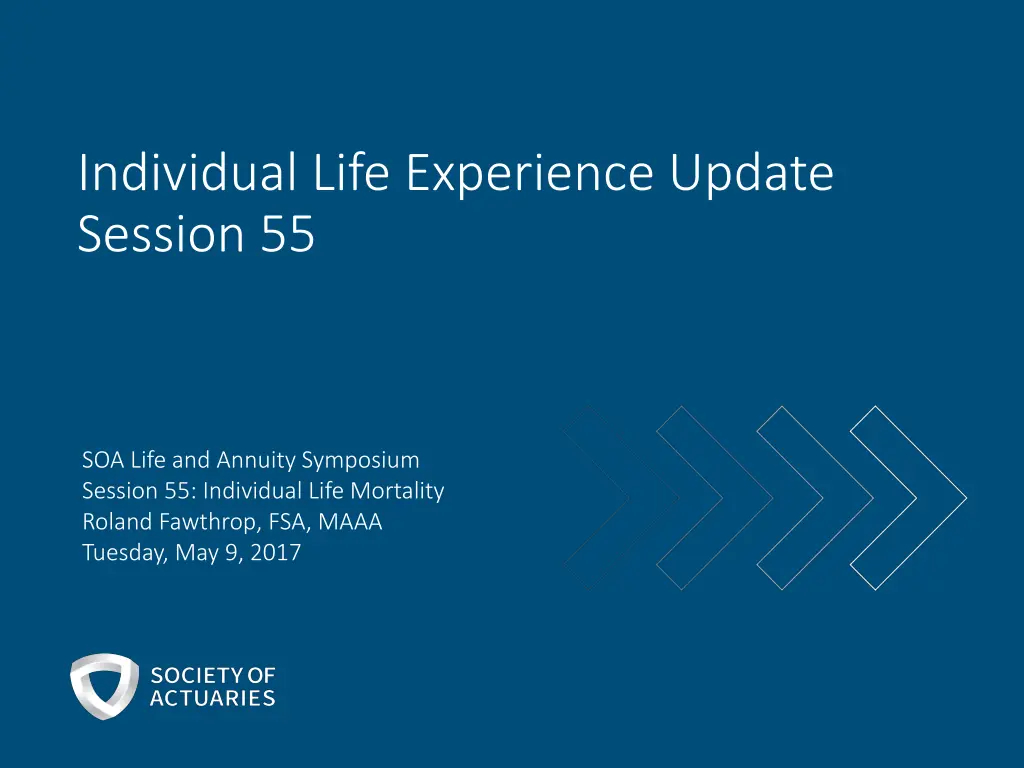
New Individual Life Mortality Study Overview
Explore the details of the new Individual Life Mortality Study update presented at the SOA Life and Annuity Symposium. The study covers experience data from 2009 to 2013, including information on exposure years, term products, nonforfeiture elections, and more. Additional supplementary data on cause of death, lapses, and observation years is also provided. Discover the differences in data collected between 2013 and 2009, highlighting increases in companies, claims, claim amounts, exposure years, and more. The mortality experience details by face amounts for various observation years are also included in the study analysis.
Download Presentation

Please find below an Image/Link to download the presentation.
The content on the website is provided AS IS for your information and personal use only. It may not be sold, licensed, or shared on other websites without obtaining consent from the author. If you encounter any issues during the download, it is possible that the publisher has removed the file from their server.
You are allowed to download the files provided on this website for personal or commercial use, subject to the condition that they are used lawfully. All files are the property of their respective owners.
The content on the website is provided AS IS for your information and personal use only. It may not be sold, licensed, or shared on other websites without obtaining consent from the author.
E N D
Presentation Transcript
Individual Life Experience Update Session 55 SOA Life and Annuity Symposium Session 55: Individual Life Mortality Roland Fawthrop, FSA, MAAA Tuesday, May 9, 2017
An Overview of the New Individual Life Mortality Study New experience: 2009 2013 Calendar Years Prior ILEC data will be made available within same file All study years back to 2002-2003 (previous studies used anniversary-to-anniversary approach) In data file and the slides that follow, the exposure year refers to the calendar year in which the policy year ends Standard Ordinary, fully underwritten business Preferred Class detail Term products split by level term period And much more! 2
2009 2013 experience data also includes: Post-Level Term experience Nonforfeiture Elections (ET, RPU) Experience at small face amounts $1 - $9,999 $10,000 - $24,999 3
Additional supplementary data Types Cause of death Substandard Converted policies Lapses Collected Observation year 2012 Review of information collected Insufficient data for a report Next data sets Observation years 2013-2014 collected in 2016 Observation years 2014-2015 collection in 2017 4
New data sources 2009 NY mandated data KS voluntary data Minus 2009 data from companies already included in prior study 2010 NY mandated data KS voluntary data 2011 2013 NY mandated data KS mandated data 5
Differences Data collected in 2013 vs. 2009 (prior study only) Type Type Percent increase Percent increase No. of companies (37 -> 88) +138% No. of claims +53% Claim amounts +186% Exposure policy years +66% Exposure amount years +142% Larger average policy face amounts Lower A/E claims experience Much larger experience dataset 4.4 million claims over 11 observation years 6
Mortality experience All face amounts By face amount (Expected = 2015 VBT) SOA collected (Previously available) 110% Statistical Agent collected (new) 96% Observation Year Total Combined 101% 2003 119% 119% 2004 115% 115% 2005 110% 110% 2006 110% 110% 2007 108% 108% 2008 108% 108% 2009 104% 98% 101% 2010 98% 98% 2011 98% 98% 2012 96% 96% 2013 94% 94% 7
Mortality experience Face amounts $100K+ By face amount (Expected = 2015 VBT) SOA collected (Previously available) 105% Statistical Agent collected (new) 92% Observation Year Total Combined 96% 2003 114% 114% 2004 110% 110% 2005 106% 106% 2006 105% 105% 2007 104% 104% 2008 103% 103% 2009 99% 94% 97% 2010 94% 94% 2011 94% 94% 2012 92% 92% 2013 89% 89% 8
Exposures are shifting toward higher face amounts Observation Year 25k-49K 50K-99K 100K-249K 2003 16.4% 25.2% 36.9% 2004 15.3% 24.3% 36.7% 2005 15.1% 22.9% 35.2% 2006 15.2% 24.0% 35.0% 2007 14.9% 23.7% 34.3% 2008 15.0% 22.9% 32.5% 2009 13.2% 20.3% 32.0% 2010 14.0% 19.5% 31.1% 2011 12.1% 17.0% 31.8% 2012 11.6% 15.6% 31.1% 2013 11.7% 16.6% 31.2% Face Amount 250K-499K 12.9% 13.8% 14.8% 14.7% 14.9% 15.8% 18.1% 18.1% 19.8% 20.2% 20.2% 500K-999K 5.7% 6.6% 7.6% 7.4% 8.0% 9.0% 10.6% 10.7% 12.0% 13.1% 12.6% 1M+ 2.9% 3.3% 4.3% 3.8% 4.2% 4.8% 5.8% 6.5% 7.3% 8.3% 7.8% % s are by Policy Count All durations 9
and shift into ultimate durations Observation Year 2003 2004 2005 2006 2007 2008 2009 2010 2011 2012 2013 Duration 1-5 37.4% 37.2% 33.9% 32.9% 31.2% 31.5% 31.2% 27.1% 28.9% 26.8% 27.7% 6-10 23.1% 23.2% 23.4% 22.6% 23.0% 23.4% 26.4% 23.2% 24.8% 24.1% 23.1% 11-15 20.2% 18.9% 17.8% 17.0% 16.3% 14.7% 14.2% 15.7% 16.7% 17.5% 17.8% 16-20 14.9% 15.1% 16.2% 16.4% 16.2% 14.5% 12.0% 12.6% 10.8% 10.6% 10.1% 21-25 2.7% 3.9% 6.3% 8.4% 10.4% 11.8% 10.7% 11.8% 9.9% 9.9% 9.2% 26+ 1.6% 1.7% 2.3% 2.7% 2.9% 4.0% 5.5% 9.7% 9.0% 11.2% 12.0% % s are by Policy Count All durations 10
Average Face Amount by Duration Observation Year Duration 1-5 6-10 11-15 16-20 21-25 26+ 2003 271,401 169,145 108,149 77,283 56,598 43,922 2004 295,802 185,741 113,717 81,241 60,250 44,821 2005 335,591 229,267 132,295 93,594 69,390 46,651 2006 330,246 215,337 126,503 95,816 69,853 48,181 2007 358,141 232,497 134,670 99,612 72,269 50,138 2008 375,346 254,975 148,044 105,677 77,846 51,350 2009 388,308 301,900 185,501 117,000 87,191 62,751 2010 436,266 348,869 217,170 129,284 99,189 72,974 2011 444,218 379,480 247,227 135,869 99,556 72,599 2012 487,285 425,849 285,755 154,042 108,143 77,151 2013 436,123 421,538 292,926 163,614 109,918 78,913 11
Mix of business by Gender/Class Observation Year 2003 2004 2005 2006 2007 2008 2009 2010 2011 2012 2013 Gender/Tobacco Class Male TB 8% 7% 7% 8% 7% 6% 5% 6% 5% 5% 5% Male NT 49% 49% 50% 49% 49% 50% 50% 49% 49% 50% 49% Female NT 35% 36% 35% 36% 36% 38% 38% 37% 39% 39% 39% Female TB 4% 4% 4% 5% 4% 3% 3% 3% 3% 3% 3% % s are by Policy Count All durations Approx. 4% are unknown tobacco/smoker class 12
and Females 16
and Tobacco 18
Differences by Plan? 25,000- 49,999 50,000- 99,999 100,000- 249,999 250,000- 499,999 500,000- 999,999 Insurance Plan 1,000,000+ Grand Total Perm 115% 104% 91% 87% 84% 86% 92% Term 176% 145% 105% 90% 84% 82% 90% UL 131% 123% 109% 105% 102% 93% 103% ULSG 123% 113% 97% 94% 94% 87% 90% VL 120% 112% 100% 96% 102% 107% 104% VLSG 122% 115% 102% 96% 94% 113% 105% Total 126% 118% 102% 93% 89% 88% 94% A/E by Amount, 2015VBT Durations 1-25 Only Study Years 2009-2013 19
Preferred Class Experience 2 Nontobacco Class Structure Class 1-5 6-10 11-15 16-20 21-26 26+ Grand Total 1 Claim Count 1,322 3,857 6,296 7,278 3,540 928 23,221 A/E 2015 68.2% 82.2% 88.3% 90.9% 89.4% 99.0% 86.1% 2 Claim Count 2,491 6,028 8,148 6,463 3,886 1,416 28,432 A/E 2015 115.8% 115.5% 119.0% 129.3% 118.7% 113.1% 119.2% Total Claim Count 3,813 9,885 14,444 13,741 7,426 2,344 51,653 A/E 2015 88.8% 98.6% 101.7% 104.7% 101.9% 106.2% 100.6% Study Years 2009-2013 Face amounts $100k+ A/E by amount Note: Classes are numbered from best to residual (best class is 1) 20
Preferred Class Experience 3 Nontobacco Class Structure Class 1-5 6-10 11-15 16-20 21-26 26+ Grand Total 1 Claim Count 1,797 3,733 3,740 380 2 3 9,655 A/E 2015 64.7% 69.5% 74.9% 72.4% 6.3% 21.2% 70.1% 2 Claim Count 2,216 5,034 3,676 454 4 1 11,385 A/E 2015 74.4% 77.9% 87.4% 90.6% 6.7% 1.6% 79.5% 3 Claim Count 5,176 9,633 4,108 274 56 58 19,305 A/E 2015 105.6% 104.2% 108.5% 93.6% 39.5% 24.8% 104.2% Total Claim Count 9,189 18,400 11,524 1,108 62 62 40,345 A/E 2015 86.2% 87.5% 88.3% 84.4% 32.3% 22.6% 87.0% Study Years 2009-2013 Face amounts $100k+ A/E by amount Note: Classes are numbered from best to residual (best class is 1) 21
Preferred Class Experience 4 Nontobacco Class Structure Duration Class 1 1-5 6-10 11-15 16-20 21-25 26+ Total Claim Count A/E 2015VBT Claim Count A/E 2015VBT Claim Count A/E 2015VBT Claim Count A/E 2015VBT Claim Count A/E 2015VBT 2,577 69.6% 2,320 86.6% 1,870 97.4% 2,219 123.0% 8,986 87.9% 4,221 68.8% 4,091 81.8% 2,532 90.5% 2,561 123.6% 13,405 82.2% 2,096 62.9% 2,014 85.4% 1,164 105.0% 35 0 0 8,929 68.0% 8,439 84.2% 5,575 95.5% 5,764 121.5% 28,707 84.0% 93.2% 0.0% 0.0% 2 14 0 0 121.9% 0.0% 0.0% 3 9 63.6% 4 967 13 3 1 110.0% 6,241 79.5% 95.1% 28.4% 20.4% Total 71 3 1 94.9% 23.1% 18.3% Study Years 2009 2013 Face Amounts $100,000+ A/E s by Amount Note: Classes are numbered from best to residual (best class is 1) 22
Considerations when evaluating mortality experience: shape of underlying table used as expected era during which each durational group was underwritten Transition from unismoke to SM/NS Transition from SM/NS to TB/NT Increased prevalence of preferred class underwriting Credibility Impact of using A/E s weighted by Amount Understand product designs in the experience 23
Poll survey Question 1 How do you use the Individual Life Experience Committee How do you use the Individual Life Experience Committee Mortality Study results and reports? Mortality Study results and reports? (Check all that apply) (Check all that apply) 48% 1. Educational learn more about techniques in evaluating mortality results 2. Benchmarking compare own company mortality results to industry 3. Pricing use with appropriate company-specific adjustments 4. Don t use 33% 28% 19% 1 2 3 4 24
Poll survey Question 2 Do you use and find the exhibits and/or appendix tables Do you use and find the exhibits and/or appendix tables included in the reports useful? included in the reports useful? (one response only (one response only answer closest to your situation) answer closest to your situation) 30% 1. Yes: Primary source of analysis 2. Somewhat: Only use at a high level review, pivot tables are main source for analysis 3. No: Don t use 4. Don t know 28% 23% 20% 1 2 3 4 25
Poll survey Question 3 What type of data files would you prefer? What type of data files would you prefer? (one response only (one response only answer closest to your situation) answer closest to your situation) 1. Detailed: As much detail as possible, file size is not an issue 2. Current: Current pivot table structure is fine 3. Smaller: File size limited to what MS Excel or Access (or equivalent) can handle 4. Don t use: Detail data files are not important to my company 55% 24% 11% 11% 1 2 3 4 26
Poll survey Question 4 What future supplemental mortality analysis from ILEC data What future supplemental mortality analysis from ILEC data would you be very interested in seeing? would you be very interested in seeing? (Check all that apply) (Check all that apply) 60% 1. Cause of death 2. Post level term 3. Substandard: Table rated/ flat extra 4. Term conversion 55% 51% 46% 1 2 3 4 27
Poll survey Question 5 Would Would you like to see more Predictive Modeling in ILEC you like to see more Predictive Modeling in ILEC experience studies? experience studies? (one response only (one response only answer closest to your situation) answer closest to your situation) 58% 1. Yes 2. No 3. Don t care: Not sure what it would mean in practice 39% 3% 1 2 3 28


